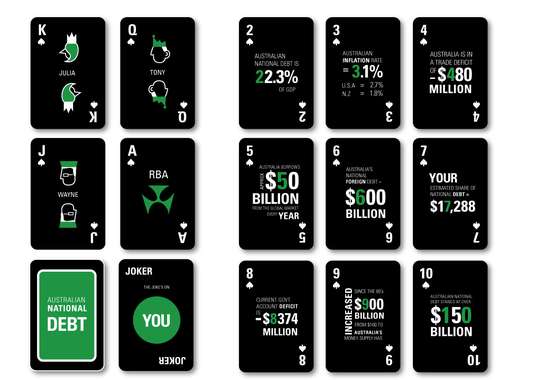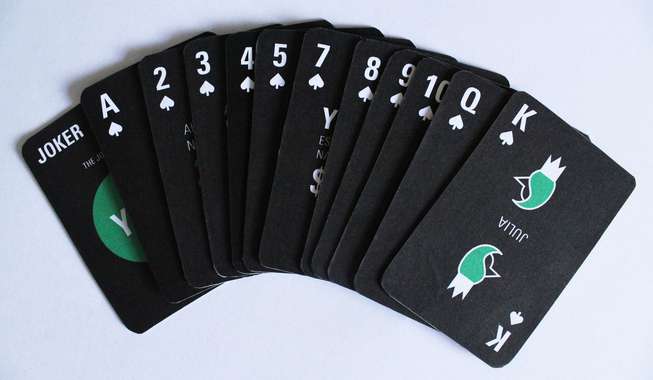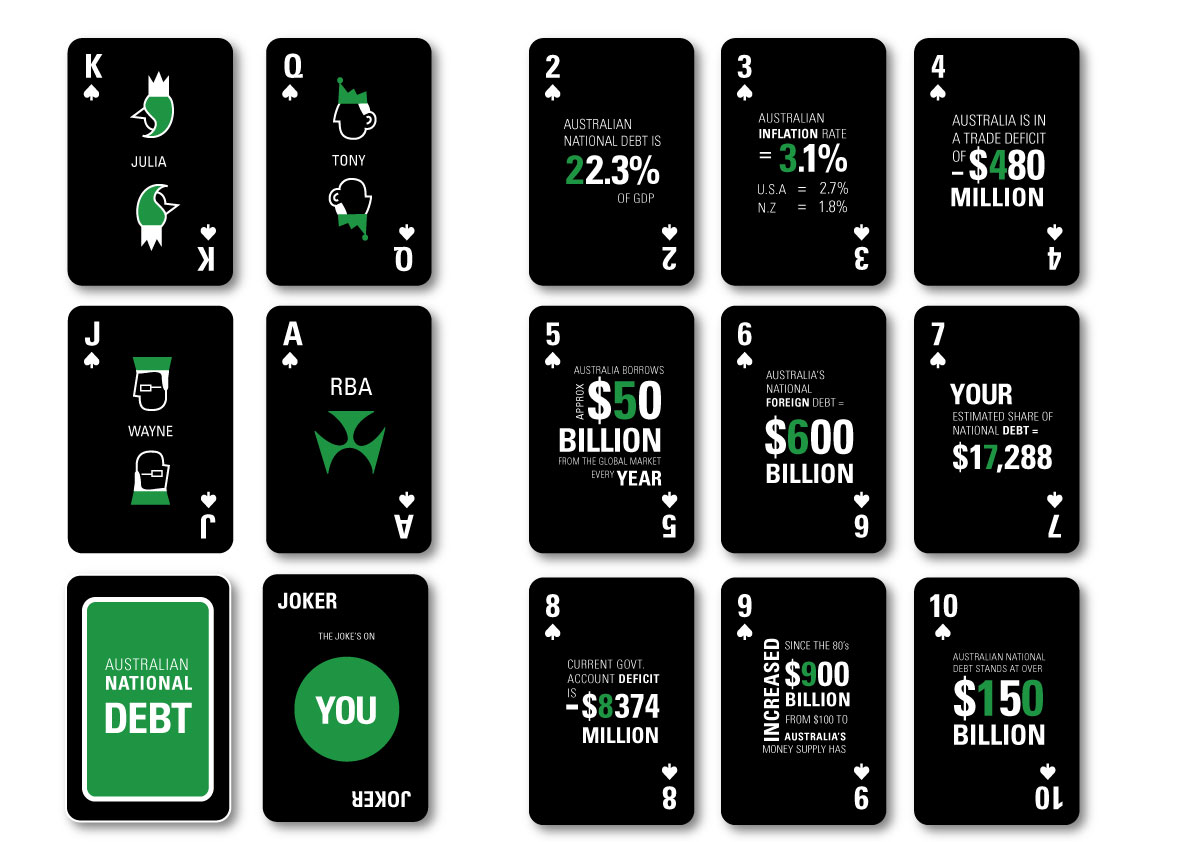National Debt Playing Cards
by kjbrowning
This work has not been commented by curators.
Title
National Debt Playing Cards
Headline
The Government is Playing Games
Concept author(s)
Kirsten Browning
Concept author year(s) of birth
1992
Concept author(s) contribution
Conceptualised and designed the work
Concept author(s) Country
Australia
Friendly Competition
Competition category
Visual communication practice
Competition subcategory
static
Competition field
academic
Competition subfield
student
Subfield description
Queensland College of Art
Check out the Debt. 2012 outlines of Memefest Friendly competition.
Description of idea
Describe your idea and concept of your work in relation to the festival outlines:
My work draws on the idea that debt is a game. Through the texts my response was that there is little information about the current debt situation in my country, Australia, and that there should be more transparency of government in this sector. As a member of the public you cannot be certain what is really going on behind the parliament walls, and it is time that we were given more knowledge when it comes to our country’s financial health. My work seeks to represent the games the government plays and exemplify the control they have over Australians. National debt is symbolised as playing cards, with major policymakers at the top – King is Julia Gillard the Australian Prime Minister etc. Each numbered card is accompanied with statistics on national debt in Australia which attempt to shock the audience. The final card is the Joker – you. This represents your place, as a member of the public, in the game of national debt. ‘The joke’s on you’ gets at the core of what my work seeks to communicate, that we are fools when it comes to our debt situation and we need to seek knowledge and educate ourselves if we are ever to win the game as a public. The government should be about people, but its immense power over the economy through debt is distorting our view of Australia as a democracy. This idea of power was drawn from David Graeber’s text which traces debt and its link to power throughout history. Debt was first put in place to enslave people under their deities and what this work shows is that this still occurs today. It is time for us to demand the truth, to demand clarity and to demand a voice when it comes to our national debt in Australia.
What kind of communication approach do you use?
I have chosen to produce a product, playing cards. These playing cards represent the games the government plays and the hierarchy of government; in relation to national bebt. This approach targets the audience through an interactive and entertaining medium and is widely available to many demographic groups. In this medium, the work is subtly subversive. When at first they would appear as regular cards they are in fact a political statement. As the audience uses these playing cards and see the statistics, politicians and the RBA being thrown around they can understand the risks which are being taken. We use playing cards to perform tricks, gamble, play games, these all relate to risk and chance. This exemplifies the risks associated with national debt at the present and will get the audience thinking.
What are in your opinion concrete benefits to the society because of your communication?
My communication gives the audience the real story. By presenting the facts people can have the knowledge and power to advocate for change. National debt affects each citizen through inflation and taxes, establishes our place in the global economy, and dictates how we live our lives. If we do not have knowledge of the facts, we as voters cannot make informed decisions when it comes to political debate and future leadership. National debt not only effects us in the present but will be handed down to future generations. It is our duty to manage present debt effectively and plan for the future.
What did you personally learn from creating your submitted work?
Through creating my work I learnt a huge deal about the real situation of national debt in Australia and how the government and economy work. I also learnt that as a designer, the power of knowledge is immense. Using my skills as a visual communicator I am able to bring to light information not before seen by a general public and present it in a way that they can understand. I can really get people thinking.
Why is your work, GOOD communication WORK?
My work achieves what it set out to do, to communicate a complex and confusing situation simply. I feel that when someone interacts with my work they will be able to understand the real situation of national debt and really question how their government works. Its visual language is clear and concise and formulated to reach a wide audience. I believe that my work would create discussion as it is implemented in a social context. People play cards together, gamble together and entertain with cards.
Where and how do you intent do implement your work?
I intend to implement my work in a few situations. Firstly it would be placed in retail outlets such as supermarkets, toy stores etc. They could also be given away and the deck given on to others, like word of mouth. The cards can also be a part of magic tricks performed in public spaces, a busking experience where the public interacts with the ‘magician’. These situations will allow the audience to interact with the work and will provide shock value with its placement in public and retail spaces.
Did your intervention had an effect on other Media. If yes, describe the effect? (Has other media reported on it- how? Were you able to change other media with your work- how?)
As of yet it has not had any effect on other media




